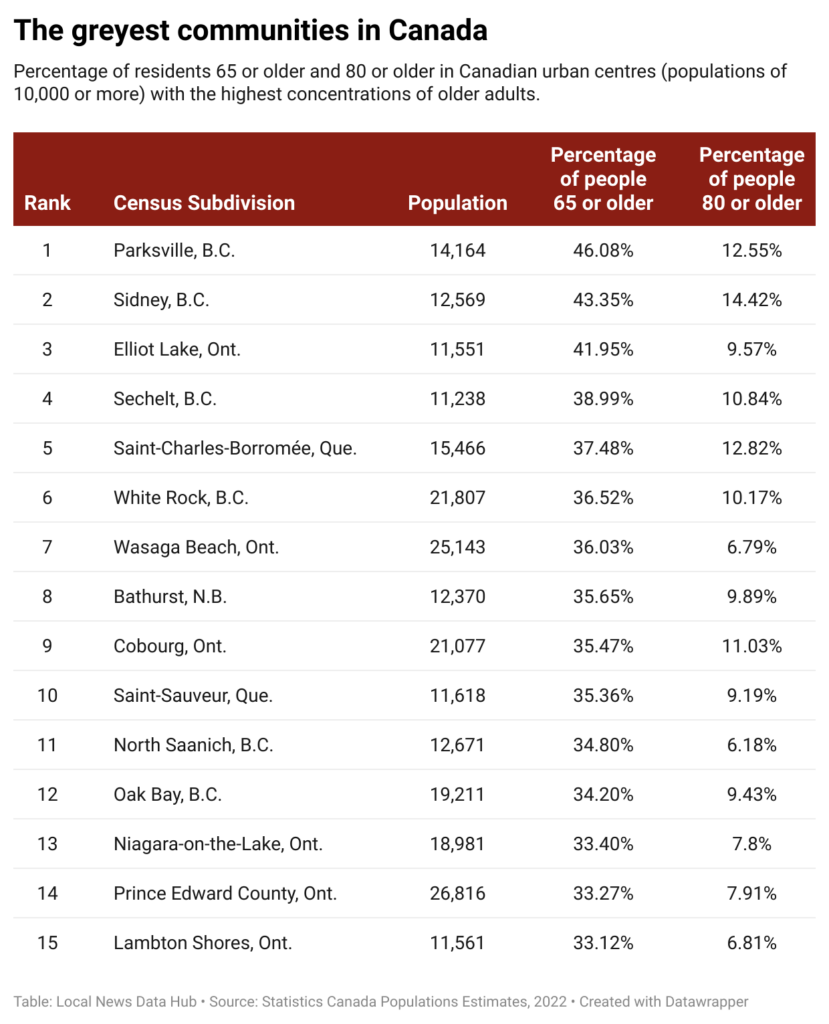
Canada now has more than 100 urban centres where at least a quarter of the population is 65 or older: new analysis
Greying communities struggle to provide support for aging residents

By Carly Penrose and Breanna Schnurr
Local News Data Hub
Feb. 7, 2024
The golden years are not all golden in the growing number of Canadian communities with high concentrations of older people, many of whom struggle with health, transportation and dementia care challenges.
There are now 111 urban centres where at least a quarter of residents are 65 or older, according to a new analysis by the Local News Data Hub at Toronto Metropolitan University (TMU). The analysis, which ranked communities based on the percentage of older residents, focused on places with at least 10,000 people because that loosely aligns with what Statistics Canada considers the minimum population for an urban centre.
First-ranked Parksville, B.C., where older people make up just over 46 per cent of the population, has the country’s highest concentration of residents 65 or older.
City councillor Sylvia Martin said younger retired people are drawn to the Vancouver Island community of about 14,000 because of its mild weather, outdoor activities and beautiful surroundings. But “when they get really old, they move back to be closer to where they’re from,” for family support and more accessible health care.
The local doctor shortage is a major “downfall” in a place that otherwise has much to offer older adults, Martin said.
In the Central Island Health Service Delivery Area, which includes Parksville, Statistics Canada data show that 5.3 per cent of people 65 or older don’t have a family physician. That’s slightly better than the national rate of 5.9 per cent, but even so “we have people every week contacting us saying they [haven’t had] a doctor for two years.”
Parksville residents are not alone in struggling with doctor shortages: Just under a third (33) of the 111 places on Local News Data Hub’s list are in health districts where at least 10 per cent of people 65 or older don’t have access to a family doctor.
The general practitioner shortage is compounded by lack of access to medical specialists in places like the northern Ontario city of Elliot Lake, where older residents make up 42 per cent of the population.
The community, which placed third in the ranking, is in the region covered by Algoma Public Health, where 8.6 per cent of older people don’t have a family physician. In many cases, Elliot Lake residents requiring specialized health-care services must drive two or more hours to Sudbury, Ont. or Sault Ste. Marie, Ont.
“If you have a really complicated medical situation…Elliot Lake is probably not for you,” said Marielle Brown, senior manager at Elliot Lake Retirement Living (ELRL), the not-for-profit retirement housing corporation that has helped market the city as an affordable retirement destination since the last uranium mine closed in 1996.
Nationally, the share of Canada’s population that is 65 or older jumped to 19 per cent in 2022, from 14 per cent in 2010. Statistics Canada estimates that number will rise to nearly 25 per cent by mid-century.
Dr. Samir Sinha, an internationally recognized geriatrician and director of health policy research at TMU’s National Institute on Aging, said the needs of older adults change over time.
“People tend to be able-bodied, healthy and independent in the first decade after retirement,” said Sinha, who is also director of geriatrics at Sinai Health System and the University Health Network.
Some older people, he added, may be drawn to more affordable communities or idyllic places with great weather. As they age, however, these same places can become “an absolute nightmare” in the absence of adequate health-care and other services.
While Elliot Lake trumpets its affordability and Parksville’s weather and location are big draws for people after retirement, communities like eighth-ranked Bathurst, N.B., have higher concentrations of older residents because younger people move away.
Anne Theriault, 73, said she loved growing up in Bathurst, but sees few advantages to aging there, apart from knowing so many people.
There is no local transit system. The city, where 36 per cent of the population is 65 or older, can get more than three metres of snow in the winter, which makes getting around even more difficult, especially for those who don’t drive. And Theriault, whose two children have moved away, said she and her husband struggle to find help with household chores.
“I’ve talked to different people who are widowed or circumstances change [who] are not physically able to do things,” she said. “They need help and they just can’t find it.”
Canada’s aging population poses additional challenges for municipalities facing what a report from the Alzheimer Society of Canada says will be a “staggering” increase in dementia cases: In 2020, 8.4 per cent of Canadians over 65 had some form of dementia. By 2050, it is forecast to be 13.2 per cent.
Already in Elliot Lake roughly 13 per cent of the total population live with a cognitive impairment, said Terry Caporossi, executive director of the Alzheimer Society of Sault Ste. Marie and Algoma District. “In a small community, I would say [that] is relatively high.”
Caporossi said the society’s Elliot Lake satellite office can’t keep up with the demand for services. The local branch offers community-based recreational therapy in town. Providing a real break for caregivers, however, is more challenging because the nearest adult day program is nearly 60 kilometres away in Blind River, Ont.

The Local News Data Hub used Statistics Canada’s 2022 population estimates to build the community ranking, which was reviewed by Sebastien Lavoie, a senior analyst at the Statistics Canada Centre for Demography. The analysis also found that:
- The municipalities with the highest concentrations of residents 65 or older tend to be smaller — 87 of the 111 communities on the Data Hub’s list have between 10,000 and 30,000 residents.
- In addition to Parksville, four other B.C. communities ranked near the top of the list. In second-place Sidney, 43 per cent of residents are 65 or older. Sechelt, where 39 per cent of people are older adults, was fourth. Meanwhile, 36.5 per cent of residents in White Rock, near Vancouver, have had a 65th birthday.
- Sidney, B.C., also stood out because about 14 per cent of its residents are at least 80, the highest proportion in the country. That compares to about 4.5 per cent for Canada as a whole.
- In addition to Elliot Lake, the list includes five other high-ranking Ontario communities. Wasaga Beach, where 36 per cent of residents are 65 or older, was seventh. In ninth-place Cobourg, older residents make up 35 per cent of the population. In Niagara-on-the-Lake, Prince Edward County and Lambton Shores, which ranked 13th, 14th and 15th respectively, residents 65 or older make up about 33 per cent of the population.
Experts point to a variety of ways communities can be more age-friendly.
Sinha’s to-do list for local governments includes ensuring older residents can get around without a car. People outlive their decision to stop driving by 10 years on average, he noted. “How do they continue to get to the grocery store? How do they continue getting out to other activities and…connect with their friends and family?”
Sinha said age-friendly communities need public spaces with bathrooms and benches with armrests so it’s easier to sit and get up.
Streets can also be made safer, he added, with changes such as extended crossing times at intersections. Statistics Canada data show that pedestrians over 70 are more than twice as likely to be killed in traffic incidents than pedestrians in any other age group.
International examples of age-friendly adaptations are also instructive. In Denmark, municipalities conduct home visits to identify older people needing care. In Singapore, families receive a housing grant for living near elderly relatives. France’s Paris Solidaire connects older adults with young people as roommates to share rent and provide companionship.
Closer to home, Vancouver International Airport offers sunflower lanyards to travellers with a cognitive impairment or other invisible disabilities. This makes it easier for airport staff, who are trained in disability and dementia awareness, to identify and accommodate them.
The Alzheimer Society of New Brunswick, meanwhile, publishes guidelines for creating dementia-friendly indoor spaces that include using low-pattern carpeted floors because shiny floors can look wet and cause confusion.
This story was produced by the Local News Data Hub, a project of the Local News Research Project at Toronto Metropolitan University’s School of Journalism. The Canadian Press is the Data Hub’s operational partner. Detailed information on the data and methodology can be found here.